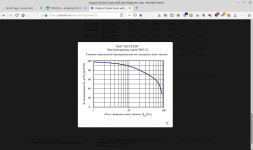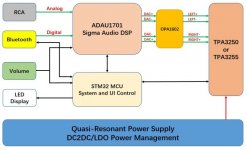and this is what I found there
Attachments
Hi cdsgames,
Yes, there is a full GND pour on all 4 layers that covers the entire PCB. These GND planes are via stitched together around the entire perimeter, and there are also local via perimeters around noise-prone nets like the pre-filter amplifier outputs, and the post inductor outputs prior to hitting the final output filter caps.
All of these traces have GND planes both above and below them, and the aforementioned perimeter stitching.
I will attach images of each layer with the GND pours on and hopefully they will make it a little more clear how everything is connected and placed.
Could you elaborate on this a bit? I'm currently using the Zobel values from the TI PFFB Application Report and they are:
Cz = 220nF
Rz = 1 ohm
Are you saying that you've found a more optimal Zobel filter for use with PFFB? If so I'm all ears! 🙂
Agreed 100%! Inter-plane capacitance can be an effective tool in reducing EMI and improving global capacitance for power nets and anything noisy. Also agreed that trying to lay this thing out correctly on a 2-layer PCB is not a good idea. It can obviously be made to work, but there are a lot of design tradeoffs that need to happen, and EMI/EMC seems to get the short end of the stick.
Thank you for the kind words! I appreciate you taking a look at the layouts. To answer your questions above:
1. Yes, it is 2 OZ copper. Small cost increase but worth the added current/thermal capacity.
2. I also don't love the overall distortion levels, even though they are lower than anything else I've seen from a TPA3255. I'd be more than happy to look at any specific suggestions you might have to improve here. I still have not tried the Coilcraft variant of the inductors, and that may help somewhat. I also have a variety of other inductors in-house I will try to see if any improvements can be made. Let me know if you have any input here.
I dont see mistakes in layout. Try different inductors and see what reduces the H3 since in all designs this is the dominating factor in THD. You should get 1db better at least..
Again I would recommend that you try bucks bunny idea of increasing gain on front end. It should give you 1-2 db more and prob lower noise N
I have not experimented with PFFB gain yet , but I am rater sure we can get a 1-2 db better
At this stage you should look at squeezing the last few db from any source. 0.0005 THD is very good already and you could prob get to 0.0002-0.0001...thats rather extraordinary .
I think that you read Electomagnetic compatibility book by H Otto...
Need to use a passive integrating circuit, + 2-4 dbI have not experimented with PFFB gain yet , but I am rater sure we can get a 1-2 db better.
That's also an interesting idea.. any reduction of harmonics (and 2 to 4db is very significant) is worth exploring
.
So why does this amplifier require a complete programmable Audio DSP chip on board ? Is volume and any other audio processing done on this chip ? Clearly it is designed for future software updates.
Any comments on the use of Bipolar Electrolytics in all the signal paths even if they are “Muse” branded. Someone said earlier that Bipolar Electrolytic Caps were not a good idea.
Why OPA1602 ? Wouldn’t the OPA1656 be todays choice ?
Otherwise looks nice and certainly safer than the Breeze HiFi intergrated unit from what you can see. Also the Breeze amplifier only supports basic Bluetooth - not the lossless variety which seems a bit strange.
The DSP is not required - it is a feature. It is ADAU1701 and with SigmaStudio You can add many kind of filters to model the desired amplitude and phase response of your speakers.
I don't like the small heatsink on this board...
I don't like the small heatsink on this board...
.
So why does this amplifier require a complete programmable Audio DSP chip on board ? Is volume and any other audio processing done on this chip ? Clearly it is designed for future software updates.
Any comments on the use of Bipolar Electrolytics in all the signal paths even if they are “Muse” branded. Someone said earlier that Bipolar Electrolytic Caps were not a good idea.
Why OPA1602 ? Wouldn’t the OPA1656 be todays choice ?
Otherwise looks nice and certainly safer than the Breeze HiFi intergrated unit from what you can see. Also the Breeze amplifier only supports basic Bluetooth - not the lossless variety which seems a bit strange.
Speaking about DSP and DAC, I wonder which is the best DAC for TPA32XX.
I know that the AK4497 is an amazing chip and works absolutely fine with all the TPA32XX amp I tested.
TPA3255 and DAC
I am using RME Adi-2 dac direct to TPA3255EVM
My friend Audiotone uses Topping D90 direct to 3e audio dual mono TPA3255
Both very happy 🙂
Enjoy...
Speaking about DSP and DAC, I wonder which is the best DAC for TPA32XX.
I know that the AK4497 is an amazing chip and works absolutely fine with all the TPA32XX amp I tested.
I am using RME Adi-2 dac direct to TPA3255EVM
My friend Audiotone uses Topping D90 direct to 3e audio dual mono TPA3255
Both very happy 🙂
Enjoy...
I am using RME Adi-2 dac direct to TPA3255EVM
My friend Audiotone uses Topping D90 direct to 3e audio dual mono TPA3255
Both very happy 🙂
Enjoy...
Cool ) I also have a Quad Dac Sabre but my dual AK4497 is far away better.
RME ADI-2 is based on AK4493 if I am not wrong ? This is more a headphone oriented DAC, is not it ?
Last edited:
Cool ) I also have a Quad Dac Sabre but my dual AK4497 is far away better.
RME ADI-2 is based on AK4493 if I am not wrong ? This is more a headphone oriented DAC, is not it ?
Hi,
I have RME Adi-2 version 1 with AK4490, a headphone amp and a bunch of features
Topping D90 has the AK4499
Enjoy... 😉
3E audio just released manual for adding PFFB on they TPA32XX amps!!!
So back to my questions what is better: PFFB or MKP caps instead of MKT?
I don't know if I should do the mod.
Amp is used for JBL PA speaker....
So back to my questions what is better: PFFB or MKP caps instead of MKT?
I don't know if I should do the mod.
Amp is used for JBL PA speaker....
The DSP is not required - it is a feature. It is ADAU1701 and with SigmaStudio You can add many kind of filters to model the desired amplitude and phase response of your speakers.
I don't like the small heatsink on this board...
Hi Dzwer.
I think you will find that the ADAU1701 provides at least the Volume Control function - There is another CPU that controls the front panel Display and likely interfaces directly with the ADAU1701.
Yes this chip supports the Sigma Studio development software and you can program it to do pretty much anything in the Audio Domain. The Chip has two inputs and four outputs. I guess only two outputs are used in this application. Seems a bit of overkill in this application as there are plenty of other chips that provide a Digital Volume Control from TI and Others.
The small Heat Sink might be due to it being based on the TPA3250 chip which is "Pad Down" and uses the PCB as a Heat Sink. They may also use the case but details are still scarce. The TPA3255 version may well look quite different !!
3E audio just released manual for adding PFFB on they TPA32XX amps!!!
So back to my questions what is better: PFFB or MKP caps instead of MKT?
I don't know if I should do the mod.
Amp is used for JBL PA speaker....
Link please
MKP only.
Thanks drMordor
So no need to do PFFB^^
http://www.3e-audio.com/wp-content/...ification-on-EAUMT-Serise-Amplifier-Board.pdf
So no need to do PFFB^^
http://www.3e-audio.com/wp-content/...ification-on-EAUMT-Serise-Amplifier-Board.pdf
Did anyone had any issues with OPA1656 in the amp. After 30 minutes of use they start with cracking noises (low frequencies). I tried to re-solder them worked for a while and start again.
I replaced them with OPA2228 and later with OPA2210 and there were no issues with those.
I soldered myself on a TI SOIP to DIP adapters (OPA1656 as well OPA2210).
The second point i would like to ask your advice/recommendation regarding the output filter for 8-Ohm speakers.
What inductors and caps to use.
As for the caps i will use your advice for Wima MKP series altough i am confused about the values.
In the excel calculator from TI the suggested value for 8-Ohm speakers is 0.68uF and 1nF with 22uH inductors but i read somewhere on this thread that is recommended to use 0.47uF instead of the 1uF default installed on the amp.
Thank you very much for your findings and advises. It is very helpful to read your comments and experiences.
I replaced them with OPA2228 and later with OPA2210 and there were no issues with those.
I soldered myself on a TI SOIP to DIP adapters (OPA1656 as well OPA2210).
The second point i would like to ask your advice/recommendation regarding the output filter for 8-Ohm speakers.
What inductors and caps to use.
As for the caps i will use your advice for Wima MKP series altough i am confused about the values.
In the excel calculator from TI the suggested value for 8-Ohm speakers is 0.68uF and 1nF with 22uH inductors but i read somewhere on this thread that is recommended to use 0.47uF instead of the 1uF default installed on the amp.
Thank you very much for your findings and advises. It is very helpful to read your comments and experiences.
Hi Dzwer.
I think you will find that the ADAU1701 provides at least the Volume Control function - There is another CPU that controls the front panel Display and likely interfaces directly with the ADAU1701.
Yes this chip supports the Sigma Studio development software and you can program it to do pretty much anything in the Audio Domain. The Chip has two inputs and four outputs. I guess only two outputs are used in this application. Seems a bit of overkill in this application as there are plenty of other chips that provide a Digital Volume Control from TI and Others.
The small Heat Sink might be due to it being based on the TPA3250 chip which is "Pad Down" and uses the PCB as a Heat Sink. They may also use the case but details are still scarce. The TPA3255 version may well look quite different !!
the DSP giving another option for these who experienced and intend to design their own EQ,just leave it as is if you just want focus on OP-AMP like replacement as many people did.
check the diagram then you may understand more on signal path go through.
more info can see in website:
TPA32xx All in One Amplifier | 3e Audio
Attachments
PFFB was patented by ICEpower and could only be used by ICEpower and some companies. So other companies struggled to improve their properties. However, this patent period should have expired in 2019, so I think that companies will adopt PFFB from now on. The PFFB frees you from the effects of load impedance and allows you to create class D amplifiers with excellent characteristics. I think 3e audio will also manufacture products that use PFFB.
- Home
- Amplifiers
- Class D
- TPA3255 - all about DIY, Discussion, Design etc

